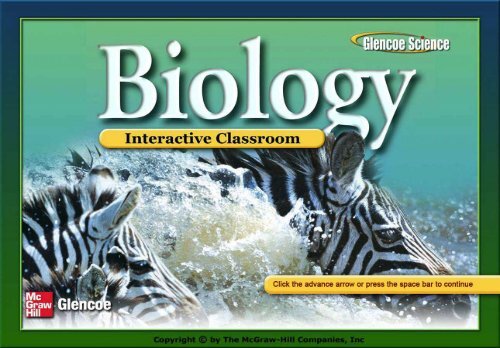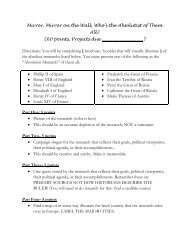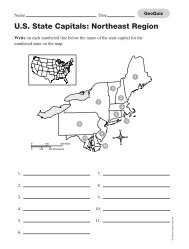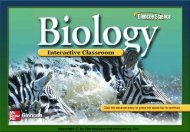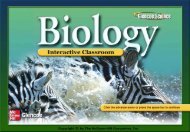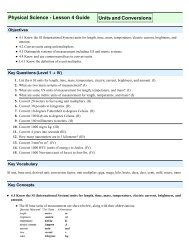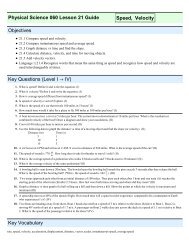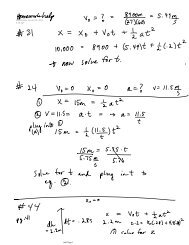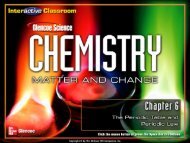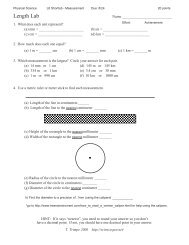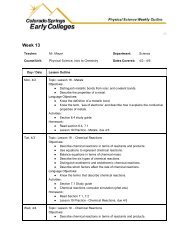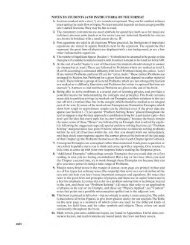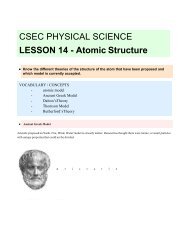Chapter 11 Complex Inheritance.pdf
Chapter 11 Complex Inheritance.pdf
Chapter 11 Complex Inheritance.pdf
- No tags were found...
Create successful ePaper yourself
Turn your PDF publications into a flip-book with our unique Google optimized e-Paper software.
<strong>Chapter</strong> <strong>11</strong><strong>Complex</strong> <strong>Inheritance</strong> and Human Heredity<strong>11</strong>.1 Basic Patterns of Human <strong>Inheritance</strong>Recessive Genetic Disorders• A recessivetrait isexpressedwhen theindividual ishomozygousrecessive forthe trait.
<strong>Chapter</strong> <strong>11</strong><strong>Complex</strong> <strong>Inheritance</strong> and Human Heredity<strong>11</strong>.1 Basic Patterns of Human <strong>Inheritance</strong>Cystic Fibrosis• Affects the mucus-producing glands,digestive enzymes, and sweat glands• Chloride ions are not absorbed into thecells of a person with cystic fibrosis butare excreted in the sweat.• Without sufficient chloride ions in the cells,a thick mucus is secreted.
<strong>Chapter</strong> <strong>11</strong><strong>Complex</strong> <strong>Inheritance</strong> and Human Heredity<strong>11</strong>.1 Basic Patterns of Human <strong>Inheritance</strong>Albinism• Caused by altered genes, resulting in theabsence of the skin pigment melanin in hairand eyes• White hair• Very pale skin• Pink pupils
<strong>Chapter</strong> <strong>11</strong><strong>Complex</strong> <strong>Inheritance</strong> and Human Heredity<strong>11</strong>.1 Basic Patterns of Human <strong>Inheritance</strong>Tay-Sachs Disease• Caused by the absence of the enzymesresponsible for breaking down fatty acidscalled gangliosides• Gangliosides accumulate in the brain,inflating brain nerve cells and causingmental deterioration.
<strong>Chapter</strong> <strong>11</strong><strong>Complex</strong> <strong>Inheritance</strong> and Human Heredity<strong>11</strong>.1 Basic Patterns of Human <strong>Inheritance</strong>Galactosemia• Recessive genetic disorder characterized bythe inability of the body to digest galactose.
<strong>Chapter</strong> <strong>11</strong><strong>Complex</strong> <strong>Inheritance</strong> and Human Heredity<strong>11</strong>.1 Basic Patterns of Human <strong>Inheritance</strong>Dominant Genetic Disorders• Huntington’s disease affects the nervoussystem.• Achondroplasia is a genetic condition thatcauses small body size and limbs that arecomparatively short.
<strong>Chapter</strong> <strong>11</strong><strong>Complex</strong> <strong>Inheritance</strong> and Human Heredity<strong>11</strong>.1 Basic Patterns of Human <strong>Inheritance</strong>
<strong>Chapter</strong> <strong>11</strong><strong>Complex</strong> <strong>Inheritance</strong> and Human Heredity
<strong>Chapter</strong> <strong>11</strong><strong>Complex</strong> <strong>Inheritance</strong> and Human Heredity<strong>11</strong>.1 Basic Patterns of Human <strong>Inheritance</strong>Pedigrees• A diagram that traces the inheritance of aparticular trait through several generations
<strong>Chapter</strong> <strong>11</strong><strong>Complex</strong> <strong>Inheritance</strong> and Human Heredity<strong>11</strong>.1 Basic Patterns of Human <strong>Inheritance</strong>Inferring Genotypes• Knowing physical traits can determine whatgenes an individual is most likely to have.Predicting Disorders• Record keeping helps scientists usepedigree analysis to study inheritancepatterns, determine phenotypes, andascertain genotypes.
<strong>Chapter</strong> <strong>11</strong><strong>Complex</strong> <strong>Inheritance</strong> and Human Heredity<strong>11</strong>.2 <strong>Complex</strong> Patterns of <strong>Inheritance</strong>Incomplete Dominance• The heterozygous phenotype is anintermediate phenotype between the twohomozygous phenotypes.
<strong>Chapter</strong> <strong>11</strong><strong>Complex</strong> <strong>Inheritance</strong> and Human Heredity<strong>11</strong>.2 <strong>Complex</strong> Patterns of <strong>Inheritance</strong>Codominance• Both alleles are expressed in theheterozygous condition.
<strong>Chapter</strong> <strong>11</strong><strong>Complex</strong> <strong>Inheritance</strong> and Human Heredity<strong>11</strong>.2 <strong>Complex</strong> Patterns of <strong>Inheritance</strong>Sickle-cell Disease• Changes in hemoglobincause red blood cells tochange to a sickle shape.• People who areheterozygous for the traithave both normal andsickle-shaped cells.Sickle cellNormal red blood cell7766x
<strong>Chapter</strong> <strong>11</strong><strong>Complex</strong> <strong>Inheritance</strong> and Human Heredity<strong>11</strong>.2 <strong>Complex</strong> Patterns of <strong>Inheritance</strong>Multiple Alleles• Blood groups inhumans• ABO blood groupshave three formsof alleles.
<strong>Chapter</strong> <strong>11</strong><strong>Complex</strong> <strong>Inheritance</strong> and Human Heredity<strong>11</strong>.2 <strong>Complex</strong> Patterns of <strong>Inheritance</strong>Coat Color of Rabbits• Multiple alleles can demonstrate a hierarchyof dominance.• In rabbits, four alleles code for coat color:C, c ch , c h , and c.
<strong>Chapter</strong> <strong>11</strong><strong>Complex</strong> <strong>Inheritance</strong> and Human Heredity<strong>11</strong>.2 <strong>Complex</strong> Patterns of <strong>Inheritance</strong>Coat Color of RabbitsChinchillaLight grayAlbinoDark grayHimalayan
<strong>Chapter</strong> <strong>11</strong><strong>Complex</strong> <strong>Inheritance</strong> and Human Heredity<strong>11</strong>.2 <strong>Complex</strong> Patterns of <strong>Inheritance</strong>Epistasis• Variety is the result of one allele hiding theeffects of another allele.eebbeeB_ E_bb E_B_No dark pigment present in furDark pigment present in fur
<strong>Chapter</strong> <strong>11</strong><strong>Complex</strong> <strong>Inheritance</strong> and Human Heredity<strong>11</strong>.2 <strong>Complex</strong> Patterns of <strong>Inheritance</strong>Sex Determination• Sex chromosomesdetermine anindividual’s gender.
<strong>Chapter</strong> <strong>11</strong><strong>Complex</strong> <strong>Inheritance</strong> and Human Heredity<strong>11</strong>.2 <strong>Complex</strong> Patterns of <strong>Inheritance</strong>Dosage Compensation• The X chromosome carries a variety ofgenes that are necessary for thedevelopment of both females and males.• The Y chromosome mainly has genes thatrelate to the development of malecharacteristics.• Chromosome inactivation• Barr bodies
<strong>Chapter</strong> <strong>11</strong><strong>Complex</strong> <strong>Inheritance</strong> and Human Heredity<strong>11</strong>.2 <strong>Complex</strong> Patterns of <strong>Inheritance</strong>Sex-Linked Traits• Genes located on the X chromosome• Red-green color blindness• HemophiliaSex-LinkedTraits
<strong>Chapter</strong> <strong>11</strong><strong>Complex</strong> <strong>Inheritance</strong> and Human Heredity<strong>11</strong>.2 <strong>Complex</strong> Patterns of <strong>Inheritance</strong>Polygenic Traits• Polygenic traits arise from the interaction ofmultiple pairs of genes.
<strong>Chapter</strong> <strong>11</strong><strong>Complex</strong> <strong>Inheritance</strong> and Human Heredity<strong>11</strong>.2 <strong>Complex</strong> Patterns of <strong>Inheritance</strong>Environmental Influences• Environmental factors• Diet and exercise• Sunlight and water• Temperature
<strong>Chapter</strong> <strong>11</strong><strong>Complex</strong> <strong>Inheritance</strong> and Human Heredity<strong>11</strong>.2 <strong>Complex</strong> Patterns of <strong>Inheritance</strong>Twin Studies• Helps scientists separate genetic contributionsfrom environmental contributions• Traits that appear frequently in identical twinsare at least partially controlled by heredity.• Traits expressed differently in identical twinsare strongly influenced by environment.
<strong>Chapter</strong> <strong>11</strong><strong>Complex</strong> <strong>Inheritance</strong> and Human Heredity<strong>11</strong>.3 Chromosomes and Human HeredityKaryotype Studies• Karyotype—micrograph in which the pairs ofhomologous chromosomes are arranged indecreasing size.• Images of chromosomes stained duringmetaphase• Chromosomes are arranged in decreasingsize to produce a micrograph.
<strong>Chapter</strong> <strong>11</strong><strong>Complex</strong> <strong>Inheritance</strong> and Human Heredity<strong>11</strong>.3 Chromosomes and Human HeredityTelomeres• Telomere caps consist of DNA associatedwith proteins.• Serves a protective function for the structureof the chromosome
<strong>Chapter</strong> <strong>11</strong><strong>Complex</strong> <strong>Inheritance</strong> and Human Heredity<strong>11</strong>.3 Chromosomes and Human HeredityNondisjunction• Cell division during which sister chromatidsfail to separate properly• Down syndromeVisualizingNondisjunction
<strong>Chapter</strong> <strong>11</strong><strong>Complex</strong> <strong>Inheritance</strong> and Human Heredity
<strong>Chapter</strong> <strong>11</strong><strong>Complex</strong> <strong>Inheritance</strong> and Human Heredity<strong>Chapter</strong> Resource Menu<strong>Chapter</strong> Diagnostic QuestionsFormative Test Questions<strong>Chapter</strong> Assessment QuestionsStandardized Test Practicebiologygmh.comGlencoe Biology TransparenciesImage BankVocabularyAnimationClick on a hyperlink to view the corresponding lesson.
<strong>Chapter</strong> <strong>11</strong><strong>Complex</strong> <strong>Inheritance</strong> and Human Heredity<strong>Chapter</strong> DiagnosticQuestionsIdentify the disease characterized by theabsence of melanin.A. albinismB. cystic fibrosisC. galactosemiaD. Tay-Sachs
<strong>Chapter</strong> <strong>11</strong><strong>Complex</strong> <strong>Inheritance</strong> and Human Heredity<strong>Chapter</strong> DiagnosticQuestionsAn individual with Tay-Sachs disease would beidentified by which symptom?A. excessive mucus productionB. an enlarged liverC. a cherry-red spot on the back of the eyeD. vision problems
<strong>Chapter</strong> <strong>11</strong><strong>Complex</strong> <strong>Inheritance</strong> and Human Heredity<strong>Chapter</strong> DiagnosticQuestionsUnder what circumstances will a recessive traitbe expressed?A. A recessive allele is passed on by bothparents.B. One parent passes on the recessive allele.C. The individual is heterozygous for the trait.D. There is a mutation in the dominant gene.
<strong>Chapter</strong> <strong>11</strong><strong>Complex</strong> <strong>Inheritance</strong> and Human Heredity<strong>11</strong>.1 FormativeQuestionsWhich of Dr. Garrod’s observations aboutalkaptonuria was most critical to his determinationthat it is a genetic disorder?A. It appears at birth and runs in families.B. It is linked to an enzyme deficiency.C. It continues throughout a patient’s life,affecting bones and joints.D. It is caused by acid excretion and resultsin black urine.
<strong>Chapter</strong> <strong>11</strong><strong>Complex</strong> <strong>Inheritance</strong> and Human Heredity<strong>11</strong>.1 FormativeQuestionsWhich is the genotype of a person who isa carrier for a recessive genetic disorder?A. DDB. DdC. ddD. dE
<strong>Chapter</strong> <strong>11</strong><strong>Complex</strong> <strong>Inheritance</strong> and Human Heredity<strong>11</strong>.1 FormativeQuestionsAlbinism is a recessive condition. If an albinosquirrel is born to parents that both have normalfur color, what can you conclude about thegenotype of the parents?A. at least one parent is a carrierB. both parents are carriersC. both parents are homozygous recessiveD. at least one parent is homozygous dominant
<strong>Chapter</strong> <strong>11</strong><strong>Complex</strong> <strong>Inheritance</strong> and Human Heredity<strong>11</strong>.2 FormativeQuestionsWhen a homozygous male animal with blackfur is crossed with a homozygous female withwhite fur, they have offspring with gray fur.What type of inheritance does this represent?A. dosage compensationB. incomplete dominanceC. multiple allelesD. sex-linked
<strong>Chapter</strong> <strong>11</strong><strong>Complex</strong> <strong>Inheritance</strong> and Human Heredity<strong>11</strong>.2 FormativeQuestionsOf the 23 pairs of chromosomes in humancells, one pair is the _______.A. autosomesB. Barr bodiesC. monosomesD. sex chromosomes
<strong>Chapter</strong> <strong>11</strong><strong>Complex</strong> <strong>Inheritance</strong> and Human Heredity<strong>11</strong>.2 FormativeQuestionsWhich is an example of a polygenic trait?A. blood typeB. color blindnessC. hemophiliaD. skin color
<strong>Chapter</strong> <strong>11</strong><strong>Complex</strong> <strong>Inheritance</strong> and Human Heredity<strong>11</strong>.3 FormativeQuestionsWhat does a karyotype show?A. The blood type of an individual.B. The locations of genes on a chromosome.C. The cell’s chromosomes arranged in order.D. The phenotype of individuals in a pedigree.
<strong>Chapter</strong> <strong>11</strong><strong>Complex</strong> <strong>Inheritance</strong> and Human Heredity<strong>11</strong>.3 FormativeQuestionsWhat is occurring in thisdiagram?A. multiple allelesB. nondisjunctionC. nonsynapsisD. trisomy
<strong>Chapter</strong> <strong>11</strong><strong>Complex</strong> <strong>Inheritance</strong> and Human Heredity<strong>11</strong>.3 FormativeQuestionsWhat condition occurs when a person’s cellshave an extra copy of chromosome 21?A. Down syndromeB. Klinefelter’s syndromeC. Tay-Sachs syndromeD. Turner’s syndrome
<strong>Chapter</strong> <strong>11</strong><strong>Complex</strong> <strong>Inheritance</strong> and Human Heredity<strong>Chapter</strong> AssessmentQuestionsUse the figure to describe what the top horizontalline between numbers 1 and 2 indicates.A. 1 and 2 are siblingsB. 1 and 2 are parentsC. 1 and 2 are offspringD. 1 and 2 are carriers
<strong>Chapter</strong> <strong>11</strong><strong>Complex</strong> <strong>Inheritance</strong> and Human Heredity<strong>Chapter</strong> AssessmentQuestionsWhich is not an allelein the ABO blood group?A. I AB. I OC. I BD. i
<strong>Chapter</strong> <strong>11</strong><strong>Complex</strong> <strong>Inheritance</strong> and Human Heredity<strong>Chapter</strong> AssessmentQuestionsDown Syndrome results from what change inchromosomes?A. one less chromosome on pair 12B. one extra chromosome on pair 21C. one less chromosome on pair 21D. one extra chromosome on pair 12
<strong>Chapter</strong> <strong>11</strong><strong>Complex</strong> <strong>Inheritance</strong> and Human HeredityStandardized TestPracticeIf a genetic disorder is caused by a dominantallele, what is the genotype of those who donot have the disorder?A. heterozygousB. homozygous dominantC. homozygous recessive
<strong>Chapter</strong> <strong>11</strong><strong>Complex</strong> <strong>Inheritance</strong> and Human HeredityStandardized TestPracticeAnalyze this pedigree showing the inheritance ofa dominant genetic disorder. Which would be thegenotype of the first generation father?A. RRB. RrC. rr
<strong>Chapter</strong> <strong>11</strong><strong>Complex</strong> <strong>Inheritance</strong> and Human HeredityStandardized TestPracticeShorthorn cattle have an allele for both red andwhite hair. When a red-haired cow is crossed witha white-haired bull, their calf has both red andwhite hairs scattered over its body. What type ofinheritance does this represent?A. codominanceB. dosage compensationC. epistasisD. sex-linked
<strong>Chapter</strong> <strong>11</strong><strong>Complex</strong> <strong>Inheritance</strong> and Human HeredityStandardized TestPracticeWhy are males affected by recessive sexlinkedtraits more often than are females?A. Males have only one X chromosome.B. Males have two X chromosomes.C. Males have only one Y chromosome.D. The traits are located on the Ychromosomes.
<strong>Chapter</strong> <strong>11</strong><strong>Complex</strong> <strong>Inheritance</strong> and Human HeredityStandardized TestPracticeA carrier of hemophilia and her husband, whois unaffected by the condition, are expecting ason. What is the probability that their son willhave hemophilia?A. 25%B. 50%C. 75%D. 100%
<strong>Chapter</strong> <strong>11</strong><strong>Complex</strong> <strong>Inheritance</strong> and Human HeredityGlencoe Biology Transparencies
<strong>Chapter</strong> <strong>11</strong><strong>Complex</strong> <strong>Inheritance</strong> and Human HeredityImage Bank
<strong>Chapter</strong> <strong>11</strong><strong>Complex</strong> <strong>Inheritance</strong> and Human HeredityVocabularySection 1carrierpedigree
<strong>Chapter</strong> <strong>11</strong><strong>Complex</strong> <strong>Inheritance</strong> and Human HeredityVocabularySection 2incompletedominancecodominancemultiple allelesepistasissex chromosomeautosomesex-linked traitpolygenic trait
<strong>Chapter</strong> <strong>11</strong><strong>Complex</strong> <strong>Inheritance</strong> and Human HeredityVocabularySection 3karyotypetelomerenondisjunction
<strong>Chapter</strong> <strong>11</strong><strong>Complex</strong> <strong>Inheritance</strong> and Human HeredityAnimation• Visualizing Nondisjunction


